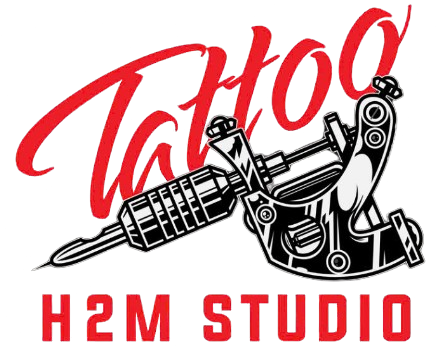A beautiful tattoo depends not only on the artist's skill but also on care, especially moisturizing. Choosing the wrong product can cause discoloration and infection, while proper moisturizing helps the skin recover quickly and keep the color lasting. In this article, H2M Tattoo Studio will share detailed instructions on what to moisturize tattoo with - from the skin's recovery mechanism, how to choose products suitable for each skin type and climate, to practical notes during the care stage.
Understanding Tattoo Moisturizing and Its Importance
The Role of Moisturizing in Tattoo Healing
When a tattoo artist creates your design, they're essentially creating thousands of tiny wounds in your skin where ink is deposited. Your body's natural healing process kicks in immediately, but this process requires optimal conditions to produce the best results.
Proper moisturizing serves several critical functions in tattoo healing:
- Facilitates Skin Regeneration: Moisturized skin cells regenerate more efficiently than dry ones. When your skin has adequate moisture, it can produce new, healthy cells to replace the damaged tissue more effectively. This process is essential for incorporating the tattoo ink into your skin's structure permanently.
- Prevents Excessive Scabbing: While some light scabbing is normal during tattoo healing, excessive or thick scabs can pull out ink when they fall off, leading to patchy or faded areas in your tattoo. Proper moisturizing keeps the skin supple and prevents the formation of thick, problematic scabs.
- Maintains Color Integrity: Well-moisturized skin retains tattoo pigments better than dry skin. When skin becomes too dry during healing, it can crack and flake excessively, potentially taking ink particles with it and resulting in a less vibrant final result.
- Reduces Itching and Discomfort: Dry, healing skin is notoriously itchy. Moisturizing helps alleviate this discomfort, reducing the temptation to scratch or pick at your tattoo—behaviors that can cause serious damage to the healing artwork.
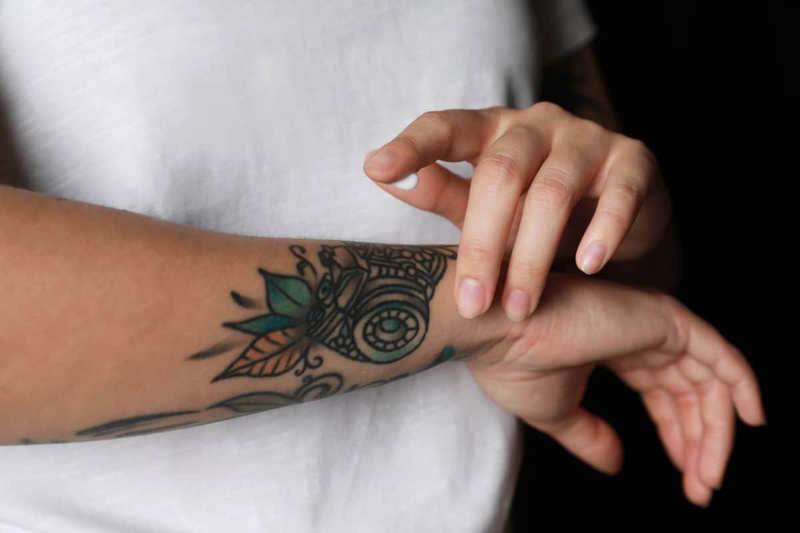
Risks of Incorrect Moisturizing
Understanding what can go wrong is just as important as knowing what to do right. Incorrect moisturizing practices can lead to several complications:
Over-Moisturizing Consequences: Applying too much moisturizer or moisturizing too frequently can create an overly moist environment that:
- Clogs pores and prevents proper air circulation
- Creates conditions favorable for bacterial growth
- Can cause the skin to become overly soft, making it more susceptible to damage
- May lead to prolonged healing times
Using Unsuitable Products: Not all moisturizers are created equal, and using the wrong type can cause:
- Allergic reactions that inflame the tattoo area
- Chemical burns from harsh ingredients
- Fading or color distortion from incompatible substances
- Increased risk of infection from contaminated or inappropriate products
Research from dermatological studies indicates that proper moisturizing can improve healing times by up to 25% while reducing complications significantly when done correctly.
>>>> READ MORE: can you put sunscreen on a healing tattoo ? Common Mistakes To Avoid
what to choose a good moisturizer for tattoos
Fragrance-Free and Hypoallergenic Properties
The ideal tattoo moisturizer should be as gentle as possible on your healing skin. Fragrances, even natural ones, can cause irritation and allergic reactions in sensitive, damaged skin. Hypoallergenic formulations are specifically designed to minimize the risk of allergic reactions, making them safer choices for tattoo aftercare.
When examining product labels, look for terms like "fragrance-free," "unscented," and "hypoallergenic." However, be aware that "unscented" doesn't always mean fragrance-free, some products use masking fragrances to hide chemical odors.
Key Beneficial Ingredients
Certain ingredients have proven particularly beneficial for tattoo healing:
- Shea Butter: This natural fat extracted from African shea nuts contains vitamins A and E, along with anti-inflammatory properties. It provides excellent moisturization without clogging pores and has been shown to promote healing in clinical studies.
- Vitamin E: A powerful antioxidant that helps protect healing skin from free radical damage while supporting the skin's natural repair processes. It's particularly effective at preventing scar tissue formation.
- Panthenol (Pro-Vitamin B5): This ingredient has exceptional healing properties and helps maintain skin moisture levels. It's been clinically proven to reduce inflammation and speed up the healing process.
- Glycerin: A humectant that draws moisture from the environment to the skin, helping maintain optimal hydration levels throughout the healing process.
- Jojoba Oil: Technically a liquid wax, jojoba oil closely mimics the skin's natural sebum, making it easily absorbed without leaving a greasy residue.
Ingredients to Avoid
- Equally important is knowing which ingredients can harm your healing tattoo:
- Alcohol: Extremely drying and can damage healing tissue while causing unnecessary pain and irritation.
- Parabens: These preservatives can cause allergic reactions and have been linked to skin sensitivity in some individuals.
- Synthetic Fragrances and Dyes: These additives serve no healing purpose and significantly increase the risk of allergic reactions.
- Harsh Chemicals: Ingredients like sodium lauryl sulfate or other strong detergents can strip natural oils and irritate healing skin.
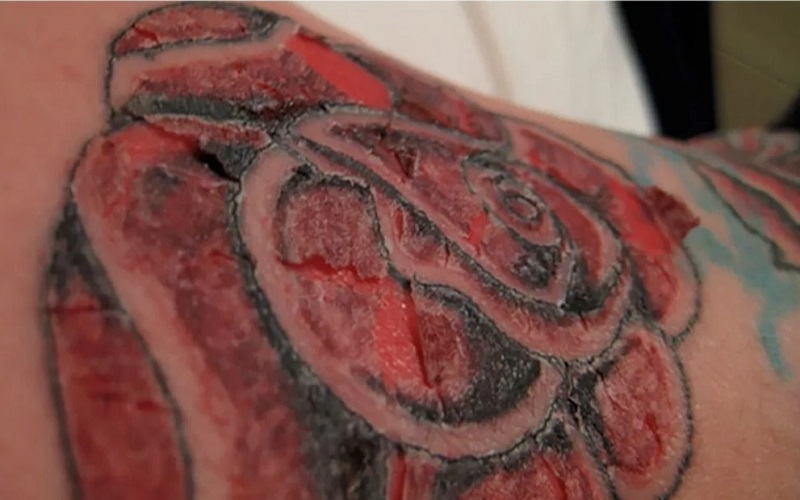
>>>> SEE MORE: can i drink beer after a tattoo ? Important Things You Need To Know
Types of Moisturizers Recommended for Tattoo Care
Healing Ointments
Healing ointments like Aquaphor are typically recommended for the initial healing phase, usually the first 3-5 days after getting your tattoo. These products create a protective barrier while allowing the skin to breathe.
When to Use: Apply a thin layer 2-3 times daily during the first few days when your tattoo is still weeping or feeling particularly tender.
Application Method: Clean your hands thoroughly, gently pat the tattoo dry, and apply just enough ointment to create a light, protective layer. The tattoo should not look glossy or feel sticky after application.
Lotions
Unscented lotions become the go-to choice once your tattoo stops weeping and begins the dry healing phase, typically after the first week.
Popular Choices:
- Lubriderm Daily Moisture Lotion (unscented)
- Aveeno Daily Moisturizing Lotion
- CeraVe Daily Moisturizing Lotion
Application Guidelines: Apply a small amount 2-3 times daily, focusing on keeping the skin hydrated without over-saturating it. The lotion should absorb completely within a few minutes.
Moreover, Popular specialized products include Hustle Butter, After Inked, and Tattoo Goo, each offering unique formulations designed specifically for tattoo healing.
>>>> READ MORE: vietnam tattoo recovery time line: How Fast Do They Heal While Traveling?
What to Correctly Apply Moisturizer to Tattoos
When to Start Moisturizing
The timing of when to begin moisturizing varies depending on your tattoo artist's specific instructions and your tattoo's condition. Generally:
- Day 1-2: Focus on gentle cleaning and may use a thin layer of healing ointment if recommended
- Day 3-5: Begin transitioning to regular moisturizing as scabbing starts to form
- Day 6 onwards: Maintain consistent moisturizing routine until fully healed
Application Frequency and Amount
Frequency: Most tattoos benefit from moisturizing 2-3 times daily. More frequent application may be necessary in very dry climates or for individuals with naturally dry skin.
Amount: Use just enough moisturizer to hydrate the skin without creating a thick, occlusive layer. A thin, even application that absorbs within 5-10 minutes is ideal.
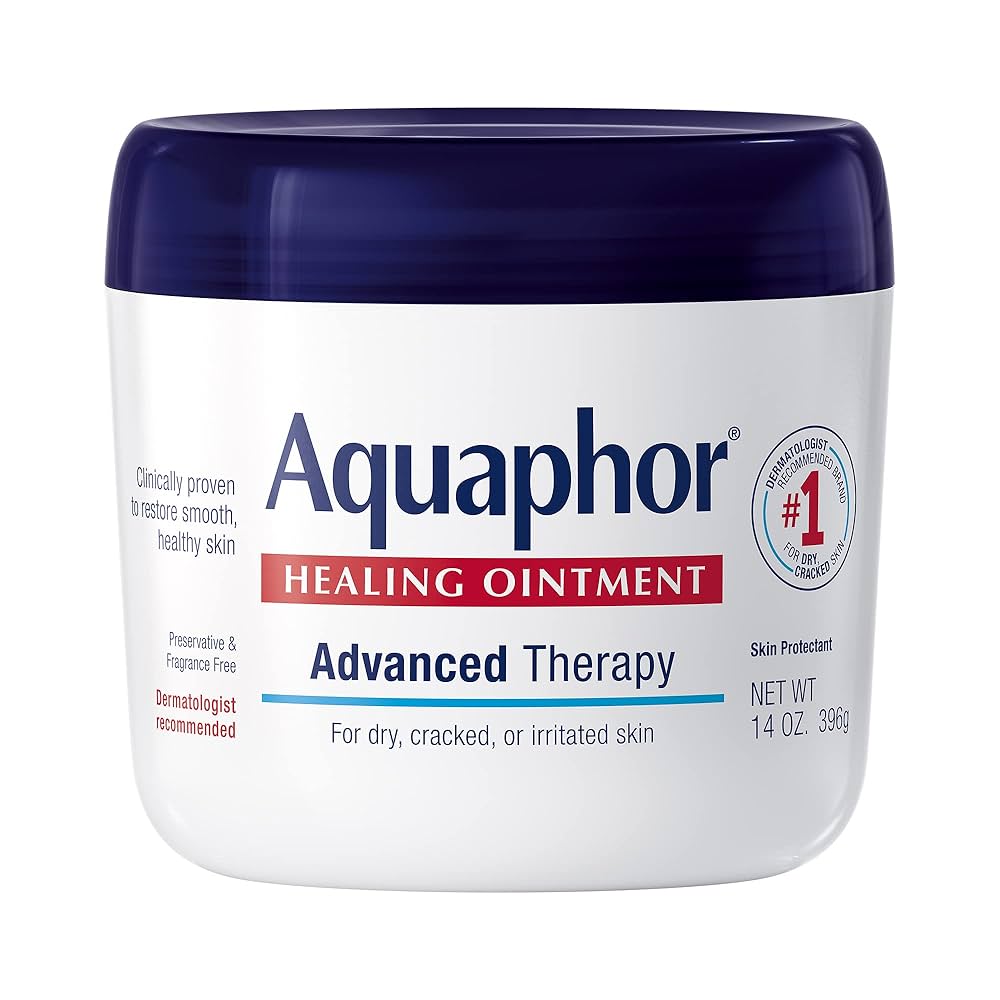
Biological protection steps when using moisturizer for tattoos
Proper hygiene is crucial to prevent infection:
- Wash your hands thoroughly with antibacterial soap
- Gently clean the tattoo area with lukewarm water and mild, fragrance-free soap
- Pat (don't rub) the area dry with a clean towel
- Apply moisturizer with clean hands or a clean applicator
Common Application Mistakes to Avoid
- Over-application: Using too much product can clog pores and slow healing
- Dirty hands: Always ensure hands are clean before touching your tattoo
- Rough handling: Be gentle when applying moisturizer—damaged skin is delicate
- Inconsistent routine: Skipping applications can lead to excessive dryness and complications
Moisturizing tattoos for different skin types and climate conditions
Moisturizing in Humid Climates
High humidity environments require adjusted aftercare routines:
- Reduced Frequency: In humid conditions, your skin naturally retains more moisture, so you may need to moisturize less frequently—possibly just once or twice daily instead of three times.
- Delayed Start: You might wait an extra day or two before beginning regular moisturizing, allowing your skin to naturally begin the healing process without excess moisture.
- Lighter Products: Choose lighter, fast-absorbing lotions over heavy ointments to prevent over-saturation in already humid conditions.
- Increased Ventilation: Ensure your tattoo gets adequate air circulation to prevent moisture buildup that could lead to bacterial growth.
Moisturizing in Dry Climates
Arid environments present opposite challenges:
- Increased Hydration Focus: You may need to moisturize more frequently and use slightly richer formulations to combat environmental moisture loss.
- Humidifier Benefits: Consider using a humidifier in your living space to maintain optimal ambient moisture levels.
- Protection from Elements: Dry, windy conditions can accelerate moisture loss, requiring more diligent aftercare.
Sensitive Skin Considerations
Individuals with sensitive skin should take extra precautions:
- Patch test any new products before applying to the tattoo
- Choose products specifically formulated for sensitive skin
- Monitor for any signs of irritation or allergic reactions
- Consider consulting with a dermatologist if you have a history of skin sensitivities
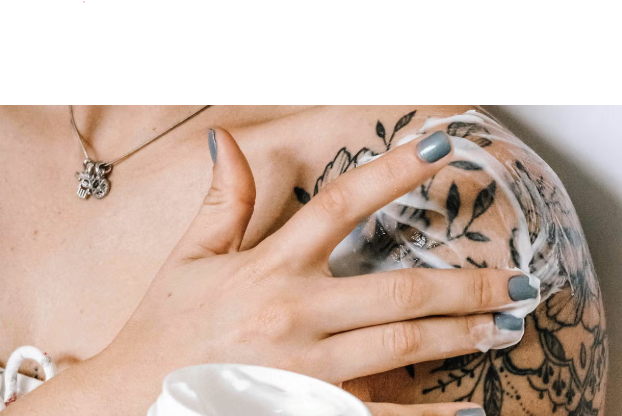
Step-By-Step Guide: Moisturizing Routine for New Tattoos
First 48 Hours Post-Tattoo: What to Do
Hour 1-6: Leave the initial bandage on as directed by your artist (typically 2-6 hours).
Initial Cleaning: Remove the bandage and gently wash the tattoo with lukewarm water and mild soap. Pat dry with a clean towel.
First Application: Apply a very thin layer of healing ointment if recommended by your artist. Some artists prefer to skip this step entirely.
Monitoring: Watch for excessive bleeding, swelling, or signs of allergic reaction.
Days 3–14: Transition to Moisturizing Phase
Day 3-5: Begin applying a fragrance-free, gentle moisturizer 2-3 times daily. The tattoo may start to feel tight and itchy as initial healing progresses.
Day 6-10: Continue regular moisturizing. Light scabbing and peeling are normal during this phase. Do not pick or scratch.
Day 11-14: Maintain moisturizing routine as skin continues to regenerate. Itching typically peaks during this period.
Beyond Two Weeks: Maintenance for Vibrant Ink
After the initial healing phase, continue moisturizing daily to maintain skin health and tattoo vibrancy. Many people find that their tattoos look best when the surrounding skin is well-maintained with regular moisturizing.
Signs Your Tattoo Needs Medical Attention
When moisturizing is insufficient or aftercare is done incorrectly, a tattoo can develop serious complications. You should seek medical attention immediately if you notice unusual symptoms such as excessive redness that worsens instead of improving, warmth or heat around the tattooed area, pus or abnormal discharge, red streaks extending from the tattoo, or fever and chills. These are warning signs that the skin may be infected and require timely medical intervention to prevent further complications.
To protect both your tattoo and your health, recognizing these warning signs early is essential. If you experience increasing pain, swelling, redness, heat, pus, or spreading red streaks, it may indicate a bacterial infection that needs prompt medical care. Allergic reactions should also not be overlooked: intense itching, hives, widespread rashes beyond the tattooed area, or difficulty breathing are all red flags that require immediate medical evaluation to avoid dangerous outcomes.
Start applying these care tips right away if you just got a new tattoo or save them for your next ink. Understanding what to moisturize a tattoo with and applying the right recovery method will help your tattoo heal quickly, keep the color beautiful and last long. Trusting the proven instructions at H2M Tattoo Studio, you can rest assured that both your body and your future tattoos will thank you for the careful care you take during this important recovery period.
>>>> NOTE NOW:

